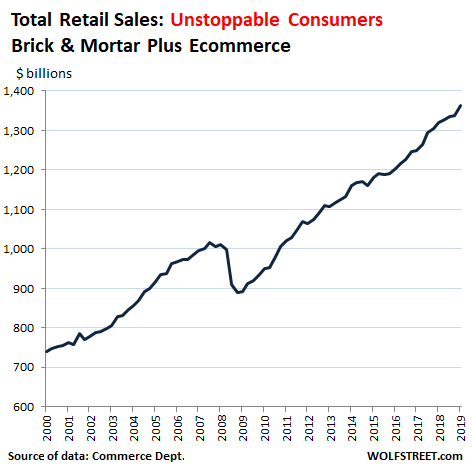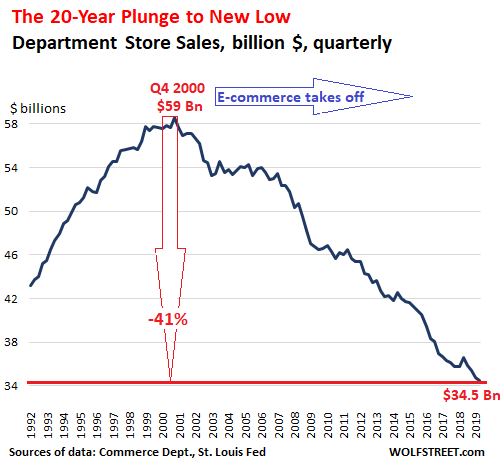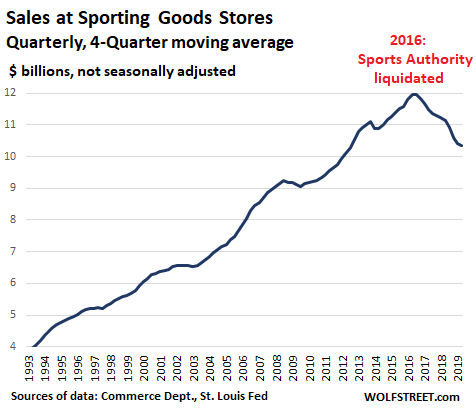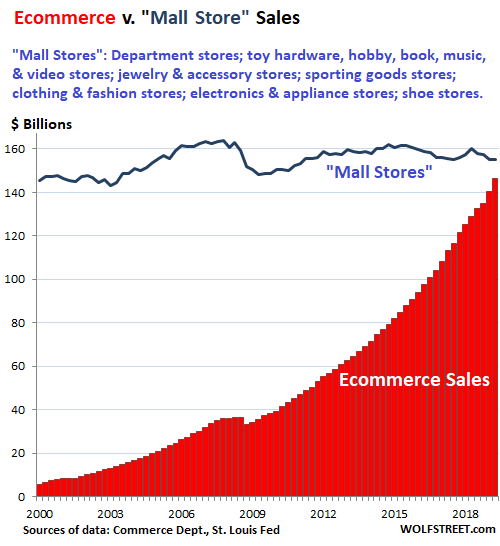Wolf Richter wolfstreet.com, http://www.amazon.com/author/wolfrichter
The segments at the core of the Brick-and-Mortar Meltdown.
Ecommerce sales in the second quarter 2019 soared 13.3% from a year ago to a new record of $146 billion (seasonally adjusted), the Commerce Department reported today. In 2018, ecommerce sales reached $522 billion, according to revised data released today; at this rate of growth, ecommerce sales will get close to $600 billion this year. Ecommerce sales have doubled in five years.
Ecommerce includes sales by the online operations of brick-and-mortar retailers. Many brick-and-mortar retailers have built thriving online operations: Walmart, Home Depot, Best Buy, Macy’s, and Costco rank in the top 10 ecommerce retailers, according to eMarketer:
- Amazon
- eBay
- Walmart
- Apple
- Home Depot
- Best Buy
- Macy’s
- Qurate Retail Group (QVC, HSN, Zulily, Ballard Designs, Frontgate, Garnet Hill,,Grandin Road)
- Costco
- Wayfair
Walmart chimed in with its earnings report last week. Walmart US sales ticked up only 2.9% to $85.2 billion; within these Walmart US sales, ecommerce sales surged 35%.
Walmart doesn’t disclose dollar-ecommerce sales, but eMarketer estimates that in 2018, Walmart US generated $21 billion in ecommerce sales, and that in 2019, it will generate $28 billion, an increase of $7 billion for the year. This would mean that brick-and-mortar sales at Walmart stores were flat at best.
Home Depot will report Q2 earnings tomorrow, but for Q1 it reported that online sales jumped 23% to $2.3 billion, and to 8.9% of total sales. This is a business that people thought would never switch much of its sales to ecommerce – given what it sells. But it’s happening
Best Buy will report Q2 earnings next week. For Q1, it reported that online revenues surged 14.5% to $1.3 billion, but that revenues at its brick-and-mortar stores fell 1.3%. So as its revenues are shifting to online, it is further reducing its brick-and-mortar footprint, according to its Q1 SEC filing:
- Will close all of its 257 remaining Best Buy Mobile stand-alone stores in the US.
- Closed 12 more of its Best Buy stores in the US over the past 12 months, down to 995 stores.
- Closed seven more of its high-end appliance stores, Pacific Sales, over the past 12 months, down to 21 stores.
Macy’s reported earnings last week – and what a brick-and-mortar doozie it was. It doesn’t disclose dollar-sales for ecommerce, but only said that ecommerce revenues experienced for the 40th quarter in a row “double-digit growth.” But total sales (which includes ecommerce sales) ticked down 0.5%, and sales at its brick-and-mortar stores fell a much faster but undisclosed rate.
These are the successful ones – the retailers that are spending and investing vast sums of money to make the transition to ecommerce, which includes building the costly fulfillment infrastructure.
The mall retailers that have not made that transition successfully are either already being dismembered in bankruptcy court, such as Sears Holdings, or will be dismembered.
Total retail sales, which includes ecommerce, in Q2 rose 3.2% year-over-year to $1.36 billion, according to revised retail trade data, released today. The increase wasn’t red-hot, but in the middle of the six-year range (from 1.5% in Q4 2015 to 5.6% in Q2 2018):

The 13.3% surge in ecommerce sales increased the share of ecommerce to 10.7% of total retail sales.
But about half of total retail sales are at these three online-resistant retailer segments: gas stations, auto dealers, and grocery and beverage stores, though grocery stores are coming under attack now, including by Amazon and Walmart.
Many of the remaining segments of brick-and-mortar stores are getting trampled by ecommerce.
Revenues at brick-and-mortar department stores in Q2 fell 5.8% year-over-year to $34.5 billion (seasonally adjusted). They’re down 41% from the peak in Q4 2000 and down 20% from the beginning of the data series in 1992. This is the slow methodical destruction of an entire segment, long a cherished destination for American shoppers that are now buying online whatever they used to buy at department stores. Macy’s brick-and-mortar sales are in this category, as are those of bankrupt Sears, Bon-Ton Stores, and Barney’s of New York. And there is no letup in sight:

Brick-and-mortar sporting goods stores were long able to sort of fight off online encroachment. But then in 2016, at the peak of their sales, a major US chain, Sports Authority, went bankrupt and was liquidated. This event shook up the sector. Many of the abandoned customers switched to online purchases when their store closed. And sales at brick-and-mortar sporting goods stores started to skid:
- Q2 2016 peak: +5.1% year-over-year (to $12.2 billion).
- Q2 2017: -4.1% year-over-year.
- Q2 2018: -3.0% year-over-year.
- Q2 2019: -7.2% year-over-year, to $10.4 billion.
Over the three years, from Q2 2016 to Q2 2019, sales have dropped 14.8% (to eliminate the effects of seasonality, I used a four-quarter moving average):

The stores that are directly hit by ecommerce competition are the classic “mall stores,” by category used by the Commerce Department. I added some samples that have already gone bankrupt. These store categories combined are depicted in the chart below as “mall stores”:
- Department stores (Sears Holdings, Bon-Ton Stores, Barney’s);
- Toy stores (Toys ‘R’ Us);
- Hardware and hobby (Orchard Supply Hardware);
- Book stores (see Borders, B. Dalton, Waldenbooks);
- Video stores (Blockbuster); music stores (Tower Records);
- Jewelry and accessory stores (Claire Stores);
- Sporting goods stores (Sports Authority);
- Clothing and fashion stores (A’Gaci, Avenue, Limited Stores, Pacific Sunwear, Aeropostale);
- Electronics and appliance stores (Circuit City, CompUSA);
- Shoe stores (Payless Shoe Source).
These “mall store” sales, all combined, fell to $155.2 billion in Q2, same level where they’d first been in 2005. Over the same period, ecommerce sales have multiplied by a factor of seven, from $20.8 billion to $146 billion. The blue line in the chart represents sales at these “mall stores”:

So, while surging year after year by the double digits for more than two decades, ecommerce is only 10.7% of total retail sales. But those total retail sales include sales at gas stations, auto dealers, and grocery and beverage stores that account for about half of total retail sales. The other half of retail sales has come under immense pressure – and entire segments, such as video and music stores, have already been wiped out.
Even as the brick-and-mortar landscape is gradually being torn up by ecommerce – something that has been going on for 20 years and may take another 20 years to complete – overall retail sales are growing at a healthy clip. And the survivors among the brick-and-mortar retailers will be those that invest vast sums and successfully make the transition to ecommerce. The others will fall by the wayside.
In 2013, I called Goldman Sachs a “snake-oil salesman” for underwriting a $1-billion J.C. Penney stock offering. Investors got wiped out. And now its longer-dated bonds, including a 100-year bond, have collapsed. Read… I’m in Awe of How Long Zombies Like J.C. Penney Keep Getting New Money to Burn. But Bankruptcy Beckons